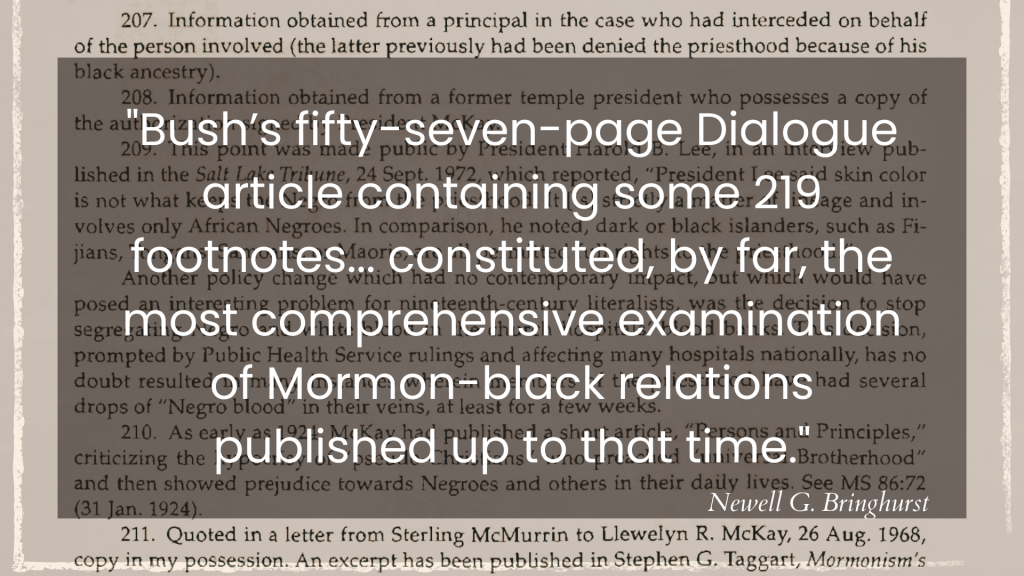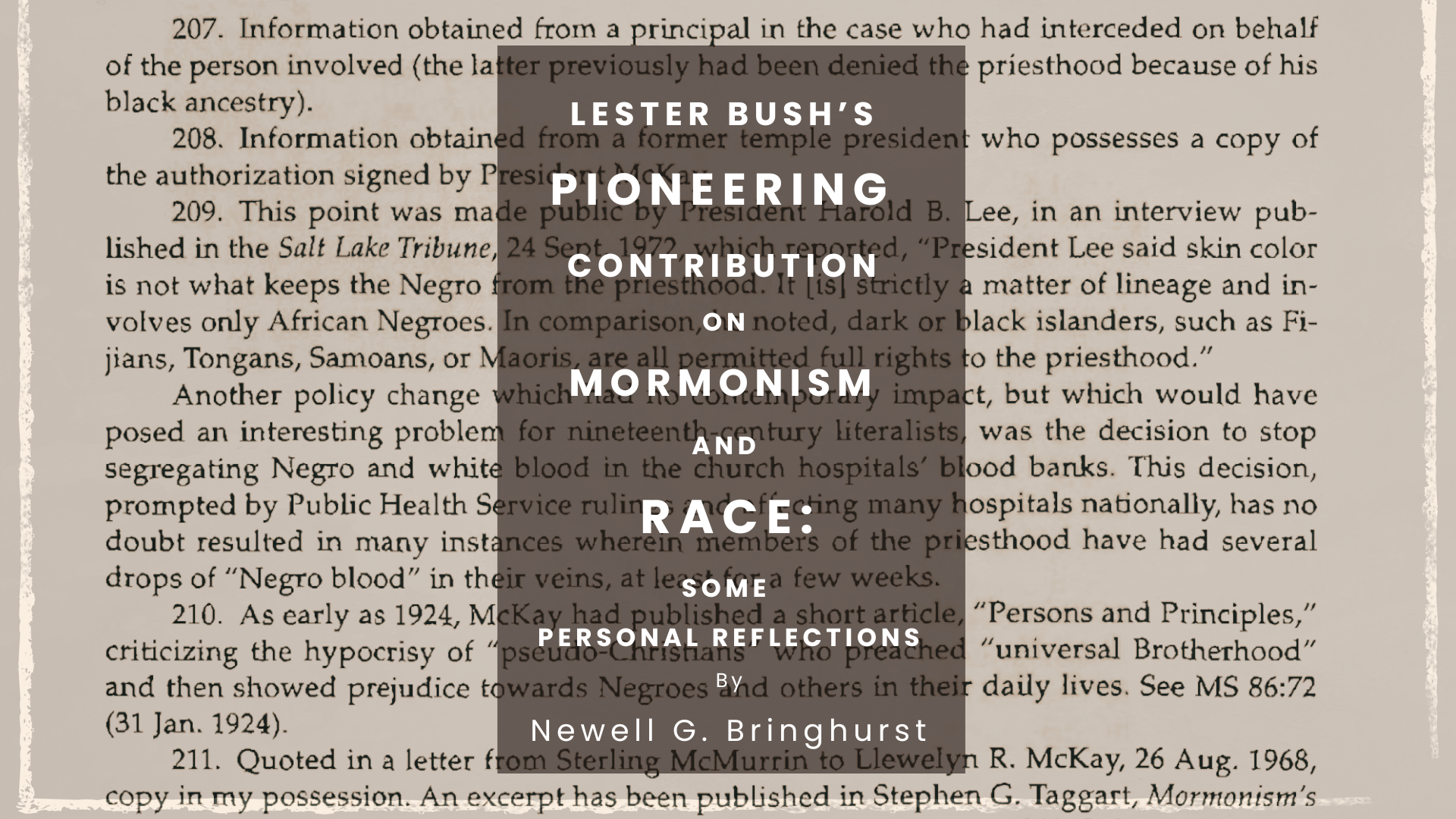Articles/Essays – Volume 57, No. 3
Lester Bush’s Pioneering Contribution on Mormonism and Race: Some Personal Reflections
On this the fiftieth anniversary of the publication of Lester E. Bush’s landmark Dialogue article “Mormonism’s Negro Doctrine: An Historical Overview,” I, along with other knowledgeable students of Mormon studies, gratefully acknowledge the crucial role his seminal 1973 work played in the ultimate lifting of the priesthood and temple ban. On a personal level I found Lester’s help and encouragement invaluable as I struggled to deal with this complex, elusive topic in my own work.
I first encountered Bush’s Dialogue essay while in the midst of researching and writing my PhD dissertation on Mormonism and Black people. In initially reading his carefully researched and precisely written description of the evolution of Black priesthood denial, I immediately despaired: What more could be said about the Mormon–Black issue? I was dismayed, disheartened, and depressed. I feared that all the research I had done over the past three years was for naught.
Indeed, his fifty-seven-page Dialogue article containing some 219 footnotes constituted by far the most comprehensive examination of Mormon–Black relations published up to that time. It drew heavily from a four-hundred-page compendium of primary and secondary documents Bush had carefully compiled over a ten-year period. Bush’s “Compilation on the Negro in Mormonism” covering the period from the 1830s to the 1970s, contains First Presidency minutes, Quorum of the Twelve meeting minutes, and other General Authority interviews and writings.
Bush’s carefully written article, which quoted a wide range of Church leaders, found no evidence whatever to support the Church’s claim that the priesthood ban was the result of divine revelation. He further discovered that the ban itself did not originate with Joseph Smith but was implemented by Brigham Young following the death of Mormonism’s founder. Bush summarily dismissed the ban itself as the unfortunate product of social historical forces—indeed, prejudices in the larger America to which Young and other Church leaders were exposed.
However, after carefully examining Bush’s essay, I determined that Bush had not sufficiently probed the fundamental origins of the ban—specifically certain systemic factors within Mormonism itself. Indeed, he completely ignored the Book of Mormon and downplayed the critical role played by Joseph Smith through his other writings, especially the Pearl of Great Price, in the initial formation of innate LDS racist attitudes. Bush also overlooked the emergence of Mormon ethnic “whiteness,” which affirmed that Latter-day Saints as the literal seed of Abraham were a divinely favored people, whereas Black people were the literal descendants of Cain, Ham, and Caanan and therefore belonged to an accursed race.

This being said, my own work benefited greatly from Bush’s pioneering work. I found most useful his carefully crafted chronological framework tracing evolving Mormon attitudes from the 1830s to the 1970s. Bush, moreover, unselfishly shared his extensive “Compilation on the Negro within Mormonism,” which enabled me to fill in significant gaps in my own research, in particular the period from 1880 to 1945, which was largely ignored in my original study, a dissertation completed in 1975. Most important, Bush carefully read and extensively critiqued that work, prompting me to make significant revisions, which I ultimately incorporated into my published 1981 book, Saints, Slaves, and Blacks: The Changing Place of Black People Within Mormonism.[1]
Indeed, Bush continued to encourage me in my own scholarship. As a co-editor of Dialogue during the late 1970s, he solicited from me an essay entitled “Elijah Abel and the Changing Status of Blacks Within Mormonism,” which was initially published in the Summer 1979 issue of Dialogue and subsequently reprinted in a 1984 volume entitled Neither White nor Black: Mormon Scholars Confront the Race Issue in a Universal Church, an anthology he and Armand L. Mauss co-edited.[2] This work also contained previous published essays written by Bush and Mauss that had appeared in Dialogue spanning the period from 1967 to 1981.
Also, in Neither White nor Black, Bush carefully critiqued my own Saints, Slaves, and Blacks, noting its strengths and weaknesses as he saw them. He acknowledged the validity of my assertion that “the metaphorical and sometimes literal racism of Mormon scripture [was] a logical precursor to an increasing lineage consciousness among the early Mormons” and the concurrent emergence of Mormon “whiteness” as a divinely favored ethnic group versus “blackness” associated with apostasy and Black biblical counter-figures. But he took issue with what he claimed was the book’s lack of “in-depth consideration of either the relevant Mormon scriptures or the personalities that interpreted them,” further asserting its failure “to analyze systematically . . . [certain] crucial later developments” contributing to the ban.[3]
As for Bush’s own 1973 Dialogue article, the author as an active, practicing Latter-day Saint hoped—indeed, anticipated—that his essay would convince Church leaders to lift the ban, given its central thesis that the ban did not originate with Joseph Smith nor was it based on divine revelation. Further undermining the ban’s legitimacy, Bush asserted that Brigham Young in implementing it was primarily influenced by attitudes and prejudices in mid-nineteenth-century American society at large. In essence, Bush characterized the ban an unfortunate aberration, at variance with essential Church doctrine and beliefs.
But alas, Bush found himself and his study under attack from high Church officials. The most prominent, then Church president Harold B. Lee, lamented that “Unfortunately [Bush’s] study quoted from the minutes of the Quorum of the Twelve that had gotten into the papers of [Apostle Adam S. Bennion].” Even more outspoken was apostle Bruce R. McConkie, who dismissed Bush’s study as “crap,” and fellow apostle Mark E. Petersen, who pushed for Bush’s excommunication, albeit unsuccessfully.[4] Moreover, Church leaders led by President Lee—an ardent defender of the ban—doubled down in affirming its legitimacy throughout the latter’s short tenure as Church president and beyond.
Finally, at long last in 1978, the ban was lifted under the leadership of then Church president Spencer W. Kimball. Ultimately, with no little irony, Bush’s basic thesis as articulated in his original essay was incorporated into the Church’s official 2013 Gospel Topics essay “Race and the Priesthood.” The essay asserts that the ban resulted from human error rather than divine will, further confessing that Brigham Young, as the instigator of the ban, “reflected the prejudices of his nineteenth century environment [where] racial distinctions and prejudices were not just common but customary among white Americans.”[5] Thus, Lester Bush, who suffered condemnation from Church leaders in the immediate aftermath of his pioneering essay, at long last found vindication.
[1] Newell G. Bringhurst, Saints, Slaves, and Blacks: The Changing Place of Black People Within Mormonism (Westport, Conn.: Greenwood Press, 1981).
[2] Newell G. Bringhurst, “Elijah Abel and the Changing Status of Blacks Within Mormonism,” as reprinted in Neither White nor Black: Mormon Scholars Confont the Race Issue in a Universal Church, edited by Lester E. Bush Jr. and Armand L. Mauss (Midvale, Utah: Signature Books, 1984), 130–48.
[3] Lester E. Bush Jr., “Whence the Negro Doctrine? A Review of Ten Years of Answers,” in Bush and Mauss, Neither White nor Black, 202.
[4] As quoted in Lester E. Bush, Jr., “Writing ‘Mormonism’s Negro Doctrine: An Historical Overview’ (1973): Context and Reflections, 1998,” Journal of Mormon History 25, no. 1 (Spring 1999): 254–59, 266–67.
[5] “Race and the Priesthood,” Gospel Topics Essays, available at https://www.churchofjesuschrist.org/study/manual/gospel-topics-essays/race-and-the-priesthood?lang=eng.


 Back to full Issue
Back to full Issue

